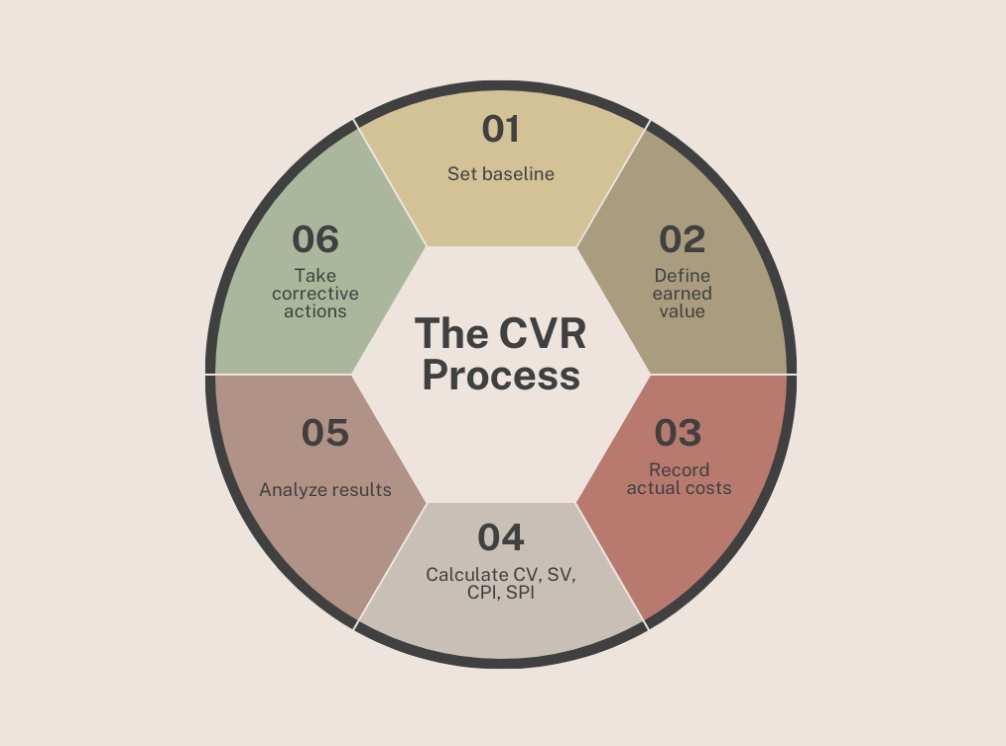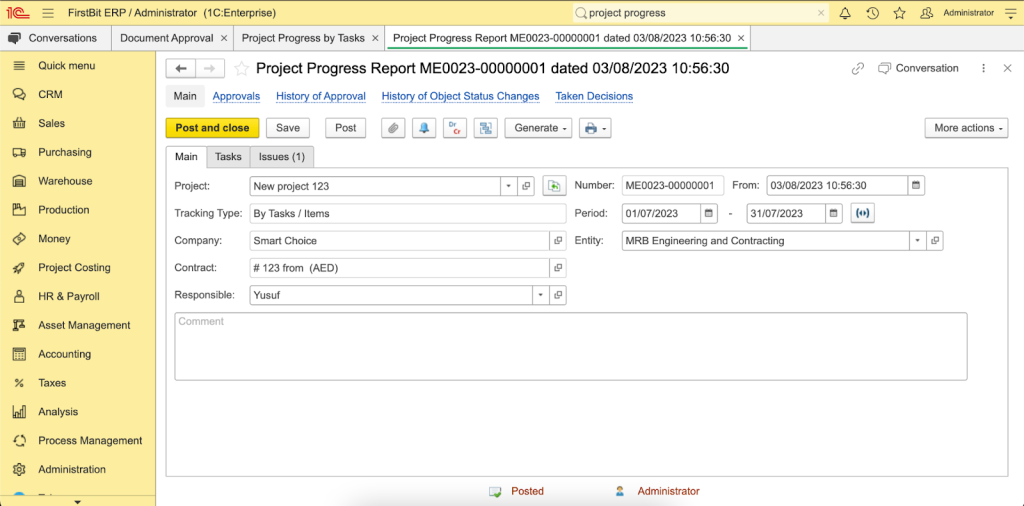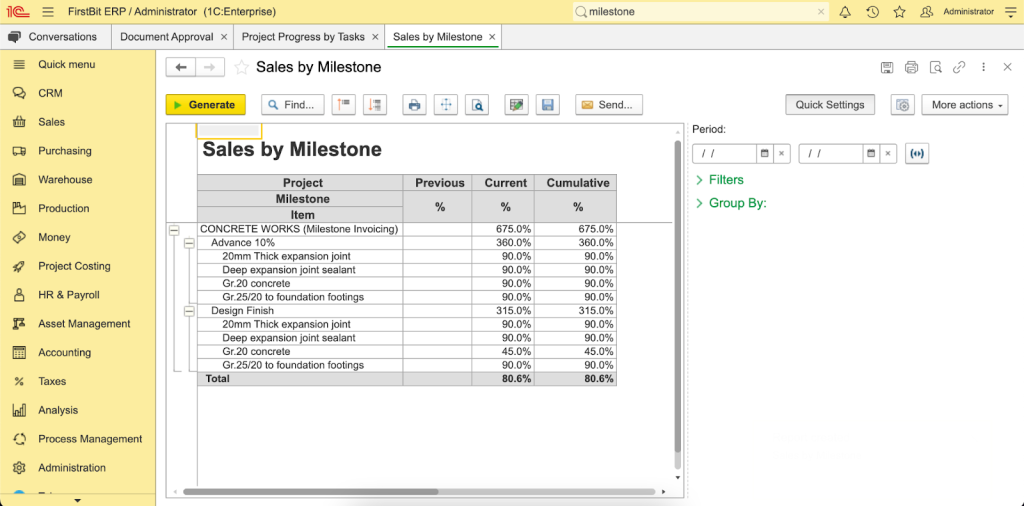You’re halfway through a construction project; everything seems fine until the final numbers come in. Suddenly, you’re over budget and scrambling to figure out what went wrong. It’s a problem that is all too familiar in the construction world, and it’s why insolvency filings in the UAE surged by approximately 29% in 2020, with the construction sector being one of the hardest hit.[?]
The issue? Missing cost discrepancies before they spiral out of control. This is where Cost Value Reconciliation (CVR) changes everything. CVR is the tool that gives you a real-time look at whether your project is on track financially, so you can catch problems early and avoid losing profit.
If you’re ready to keep your projects profitable and under control, CVR is the first step. Let’s dive into how it works.
Introduction to Cost Value Reconciliation
Cost Value Reconciliation (CVR) is a financial tool used to track and compare a construction project’s actual costs against the value of the work completed at any given point. It’s all about knowing where your project stands financially, whether you're on budget, under budget, or over budget. With this data, you can make informed decisions early on to avoid any costly surprises as the project progresses.
At its core, CVR compares two things:
-
Actual costs. What you’ve spent so far (labor, materials, equipment, overhead).
-
Earned value. The value of the work that’s been completed (as a portion of total project value).
By comparing these figures, CVR tells you how much value your work has created compared to how much you’ve spent.
One of the most notable examples of CVR in action comes from the London Crossrail project[?]. This £18 billion project faced significant challenges and cost overruns. The budget initially started at £14.8 billion, but as delays and cost increases piled up, it became clear that better financial management was needed.
Using CVR, Crossrail project managers were able to identify early on where costs were escalating, whether due to labor inefficiencies, material price increases, or scheduling delays. With this data, they could adjust plans, renegotiate contracts, and reallocate resources, helping to control the financial risks of the project despite the overrun.
Without CVR, these issues could have gone unnoticed until much later, by which time it would have been even harder to fix. Instead, the tool allowed for real-time tracking, giving managers the visibility they needed to take corrective action before small problems became larger, more expensive ones.
In essence, CVR is critical for ensuring that you don't lose track of a project’s financial health. It allows project managers to stay ahead of costs, spot issues early, and maintain profitability, especially on complex, high-budget projects like Crossrail. It’s a vital practice in today’s construction world, where every penny counts.
Understanding the Basics of CVR
If you’ve ever worked on a construction project, no matter how big or small, you know that budgets are a moving target. Materials fluctuate, timelines shift, labor costs creep in, and before you know it, the bottom line starts looking blurry. That’s where Cost Value Reconciliation (CVR) comes in. It’s not just another spreadsheet or financial report. CVR is the heartbeat of financial control in construction.
At its core, CVR tracks how much value you’ve built on-site compared to how much it’s costing you to build it. Sounds simple? It is, conceptually. But the magic lies in how it reveals the truth about your project’s financial health. Are you ahead? Behind? Bleeding cash somewhere? CVR will tell you before your CFO does.
Think of it as the reality check that keeps your project grounded. You’re not just seeing how much you’ve spent; you’re comparing spending to earned value. And in construction, “value” means physical progress — the actual work done that you can bill for.
The Benefits of CVR in Construction Projects
Implementing Cost Value Reconciliation (CVR) can deliver significant advantages across construction projects.
1. Prevents Financial Surprises
CVR is your early warning system. It gives you real-time insight into cost performance so you’re not blindsided halfway through the job.
According to KPMG’s Global Construction Survey, only 31% of projects came within 10% of their budget in the past 3 years.[?]
That’s a scary stat. CVR helps you stay out of the “budget blowout” zone.
2. Bridges Site and Finance Teams
Site teams know the work. Finance teams know the numbers. CVR brings them together. It turns boots-on-the-ground progress into measurable financial data. That kind of visibility creates better communication, faster decisions, and fewer costly misunderstandings.
3. Drives Smarter Decisions
Want to know if you’re overpaying for materials? If your subcontractors are actually delivering value for money? CVR gives you that clarity. It allows project managers and commercial teams to make data-backed decisions, not gut calls.
4. Improves Profit Margins
When done right, CVR doesn’t just avoid loss, it helps you find profit. By catching inefficiencies early, you can pivot before they become expensive problems. For contractors working on tight margins, this can be the difference between red and black.
Key Metrics Tracked by CVR
A solid CVR report doesn’t drown you in data. It zooms in on the numbers that matter:
-
Budgeted cost of work performed (BCWP). This tells you the value of the work that’s actually been completed to date. Not what you planned, what’s real.
-
Actual cost of work performed (ACWP). The actual spend on the work done so far. If this is higher than the value you’ve earned, you’ve got a problem.
-
Cost variance (CV). The difference between BCWP and ACWP. Positive means you’re under budget. Negative means you’re burning cash faster than you're earning.
-
Cost performance index (CPI). A ratio of earned value to actual cost. A CPI less than one means you’re over budget. Above 1? You’re crushing it.
-
Committed costs. These are future costs based on contracts and POs already issued. They give you a clearer picture of what’s coming down the line.
-
Forecast final cost. Based on your current performance, this is your new predicted final spend. It helps you stay agile, adjusting plans and expectations as you go.
Together, these metrics give you a live, breathing picture of your financial health. Not a lagging indicator. Not a monthly surprise. Real-time control.
Keep every project on budget
Track expenses in FirstBit ERP
Request a demo
The Process of Conducting CVR
Before a construction project falls behind schedule or overruns its budget, there are always signs. The problem is, many teams only spot them when it’s too late.
That’s where Cost Value Reconciliation (CVR) earns its weight in gold. It’s not just a tool — it’s a full process that helps you read the pulse of your project in real time. Done right, CVR tells you exactly where you stand, what’s working, and what’s veering off course.
Let’s break down how to actually conduct CVR step by step, so you’re not guessing. You’re leading with clarity.
1. Set the Baseline
Every solid analysis begins with a baseline. This is your original project budget and plan. It includes everything: labor, materials, equipment, subcontractor costs, and overheads. Without this reference point, tracking performance becomes guesswork. It’s the foundation for every calculation that follows.
2. Define Earned Value (EV)
Earned Value tells you how much measurable progress has been made in terms of value.
EV = % of Work Completed × Total Budget
For example, if you’ve completed 40% of a $500,000 project, your EV is $200,000. This figure gives you the dollar value of what’s physically been delivered on site. Not what was planned or paid for, but what’s actually been built.
3. Determine Actual Costs (AC)
This is your real-world spending to date. It includes payments made for labor, materials, equipment, and any other direct costs. If your books show $230,000 has been spent so far, that’s your AC.
Accurate tracking of AC ensures you’re not flying blind. It’s how you catch creeping costs early.
4. Evaluate Cost Variance (CV)
Now compare your earned value to your actual spend. This reveals whether you’re under or over budget.
CV = EV - AC
If your EV is $200,000 and AC is $230,000, your CV is -$30,000. That negative figure means you’ve spent more than the value you’ve built. A clear sign to investigate.
5. Evaluate Schedule Variance (SV)
Schedule Variance shows whether your progress is keeping up with your plan.
SV = EV - PV
(PV = Planned Value)
Let’s say your EV is $200,000, but your PV is $250,000. That means you’re $50,000 behind on your schedule. It’s a signal that work is moving slower than expected.
6. Evaluate Cost Performance Index (CPI)
CPI measures how efficiently you’re spending. It shows the return on every dollar.
CPI = EV ÷ AC
If EV is $200,000 and AC is $230,000, your CPI is 0.87. That means you’re getting only 87 cents of value for every dollar spent. Time to plug the leaks.
7. Evaluate Schedule Performance Index (SPI)
SPI reflects the speed of your project delivery.
SPI = EV ÷ PV
If your EV is $200,000 and PV is $250,000, your SPI is 0.8. That’s 80% of expected performance. Something’s slowing down production, and this metric helps you spot it early.
8. Analyze the Metrics
This is where numbers turn into insight. You’re not just crunching data. You’re reading the financial and operational health of the project.
| Metric | Formula | What it tells you |
| EV | % Completed × Budget | The real value of completed work |
| AC | Actual project spend | What’s actually been spent so far |
| CV | EV - AC | Whether you’re under or over budget |
| SV | EV - PV | Whether you’re behind or ahead of schedule |
| CPI | EV ÷ AC | Cost efficiency of your spending |
| SPI | EV ÷ PV | Time efficiency of your progress |
Use these side by side. One metric on its own can mislead. Together, they give you a complete story.
9. Take Corrective Actions
With the insights in hand, it’s time to respond. The goal isn’t to wait until month-end reports to react. Act early.
Examples of smart corrections:
-
Reallocate labor to speed up lagging tasks
-
Negotiate better material rates
-
Adjust your schedule to reduce idle time
-
Reassess subcontractor performance
-
Freeze non-critical spending
These aren’t drastic measures. They’re precision moves that keep the project on track and the margin intact.
10. Keep Track Continuously
CVR is not a one-and-done checklist. It’s a discipline. The teams that do this well treat CVR as a real-time system, not a monthly ritual.
-
Weekly tracking keeps field teams responsive
-
Monthly reviews guide financial strategy
-
Dashboards show live insights to spot issues before they escalate
That’s how you stay proactive. CVR done consistently means fewer surprises and stronger control throughout the project lifecycle.
Common Challenges in CVR
Even with solid processes and software in place, Cost Value Reconciliation (CVR) can still become a minefield. It's not just about whether you're doing CVR — it's about whether you're doing it well. Here's where teams often hit the wall.
1. Handling Complex Data
Construction sites generate a flood of data every single day. You've got numbers rolling in from procurement teams, subcontractors, labor shifts, material deliveries, site inspections — the list goes on. And they’re often tracked using different systems or logged manually in spreadsheets.
The challenge? None of this data is truly standardized. When timelines, formats, or update frequencies don’t align, your CVR report becomes unreliable. One late material update or a mislogged timesheet can skew your cost projections. Before you know it, you’re chasing errors instead of managing progress.
CVR is supposed to streamline financial clarity. But when the underlying data is scattered, you're spending more time cleaning it than analyzing it.
2. Ensuring Accuracy and Consistency
Data accuracy isn’t optional. CVR is a financial health check, and if the inputs are wrong, the diagnosis will be too. But construction projects often have multiple teams reporting progress in different ways — some by percentage, others by deliverables or quantities.
This inconsistency creates confusion. Suddenly, it’s unclear whether a task is actually 50% complete or just “estimated” to be. That gap between perceived and actual progress can translate into major cost misjudgments.
A 2020 study by Autodesk and FMI found that bad data caused 14% of all construction rework, adding up to over $88 billion in costs globally.[?] When you’re operating on thin margins, that kind of waste isn’t just frustrating, it’s dangerous.
3. Improving Collaboration Across Teams
CVR is not just a finance function. It’s a bridge between what's happening on-site and what’s being tracked in the office. But often, those two worlds speak entirely different languages.
Field teams focus on productivity and progress. Finance teams focus on budgets and burn rates. When they’re not aligned, CVR becomes a battleground for conflicting interpretations of the same reality. Field crews may feel their progress is undervalued, while finance may mistrust the numbers reported from site.
Without consistent communication and mutual understanding, even a well-designed CVR framework can fall apart. And when trust erodes, so does the value of the data. Eventually, CVR becomes just another report no one pays attention to.
Prevent cost overruns
Request a demo
How FirstBit ERP Software Simplifies CVR in Construction
If you’ve ever sat through a cost review meeting wondering why your numbers don’t quite add up, you’re not alone. Most construction teams are dealing with fragmented systems, delayed updates, and more spreadsheets than anyone should have to open in a day.
Cost Value Reconciliation (CVR) isn’t complicated in theory, but in practice, it becomes messy fast. The truth is, keeping financial data accurate, aligned, and current across teams and timelines takes more than a checklist. It takes the right system running quietly in the background.
That’s where FirstBit ERP fits in. It’s not just software — it’s infrastructure. Built specifically for construction, FirstBit doesn’t add another layer of admin. It connects the dots between cost, progress, and people, so your CVR becomes part of the process, not a scramble at month-end.
Here’s how it does that.
1. Live Project Financials at Your Fingertips
Timely and accurate data is crucial for effective CVR. FirstBit ERP offers real-time dashboards and progress tracking tools, providing immediate insights into project costs and performance. This real-time visibility allows for proactive decision-making, helping to identify and address potential issues before they escalate.
2. Automated CVR That Works as Hard as You Do
Manual CVR processes are prone to errors and inefficiencies. FirstBit ERP automates these processes, reducing human error and enhancing accuracy. By integrating cost control, procurement, and HR functions, the system ensures that all financial data is consistent and up-to-date, streamlining workflows and improving overall project efficiency.
3. Integrated with the Tools You Already Use
Effective CVR requires coordination between various project management aspects. FirstBit ERP seamlessly integrates with project management tools, offering features like Gantt charts and milestone tracking. This integration provides a comprehensive view of project progress, ensuring that cost assessments are aligned with actual project timelines and deliverables.
Implementing FirstBit ERP in your construction business means embracing a solution that naturally fits into your workflow, enhancing CVR processes without adding complexity. It's a strategic move towards more accurate, efficient, and integrated project management.
Key Takeaways
-
CVR is a critical financial management tool in construction that compares actual costs with the earned value of completed work, helping project teams detect and address budget issues early.
-
It creates a vital link between site progress and financial reporting, enabling better collaboration between project managers, site teams, and finance departments to make timely, informed decisions.
-
Key CVR metrics such as Cost Variance (CV), Cost Performance Index (CPI), and Schedule Performance Index (SPI) provide a clear picture of both cost efficiency and project timelines, helping teams stay on track.
-
Challenges like inconsistent data, manual processes, and poor team coordination can undermine CVR effectiveness, leading to inaccurate forecasts and increased financial risk.
-
FirstBit ERP streamlines the entire CVR process by automating cost tracking, integrating with project tools, and providing real-time financial insights, making it easier to manage costs, avoid overruns, and protect profit margins.
Get paid faster and on time
Automate invoice creation by milestones with FirstBit
Request a demo
Frequently Asked Questions
What is Cost Value Reconciliation (CVR) in construction?
Why is CVR important for construction projects?
How often should CVR be done?
Is specialized training required to use CVR tools?
Who is responsible for performing CVR?

Cedric Jackson
Contributing Author
Related terms

See FirstBit ERP solutions in action
Discover how our system solves the unique challenges of contractors in a personalized demo.
After the demo you will get a quotation for your company.
After the demo you will get a quotation for your company.










